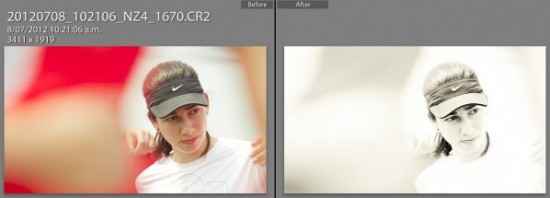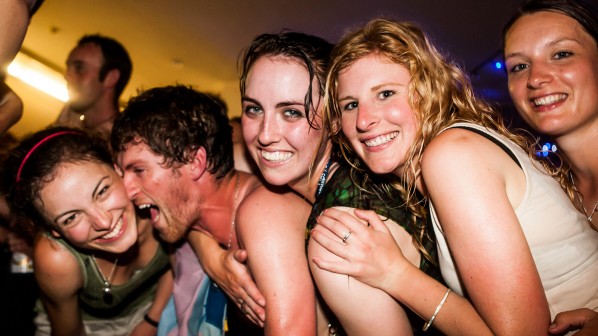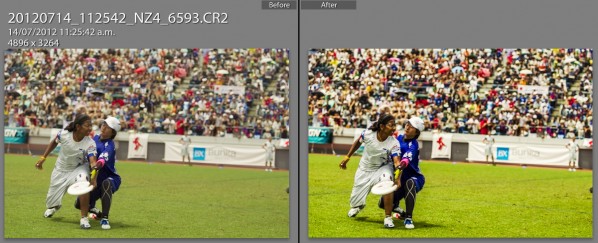Skyd is happy to present the definitive guide to Ultimate photography from our friend Neil Gardner of nzsnaps.com. We had the pleasure of working with Neil at the World Ultimate Championships in Japan this year and were extremely impressed with his work. He’s written a great guide to the ins and outs of photographing Ultimate for us and we’ll be presenting it in several parts.
A Photographer’s Guide to Shooting Top Level Ultimate (it’s not all about the size of your lens!)
Part Two: Focus and Shot Selection
Part Three: Post-Processing and Packing List
Once the last game finishes and the requisite celebration / official images are taken, I’ll race off either for food or more often to start the image download. Given that I can shoot over 25GB in a day, it takes a while to copy that to my laptop.
After copying the images to my PC, I rename all the files. Shooting with 2 cameras, it’s important to have the times (and time zone!) set correctly on both cameras. The filenames out of the camera are something like NZ4_1234.CR2 and, using some special software, I rename using the date and time from the photo’s EXIF: the resulting name would be 2012-07-15_094812_NZ4_1234.CR2. This means that photos from both cameras are now in order when I copy or otherwise manipulate the files. Many of you will have noticed that the files aren’t JPEG files – I shoot in RAW. What this means is that the data from the sensor in the camera is stored without the camera itself converting it to a JPEG picture file. I have to do that later on the computer. The advantage to shooting RAW is that the camera throws away a lot of data to make a jpg, and I only have fairly coarse control over what data it throws away. On a PC I can convert the data to a JPEG file using all the data that the camera recorded. The downsides to shooting RAW can be pretty bad though – the files take 3-4 times the space on the card, I can’t get a JPEG quickly straight from the camera and it takes time to develop (convert to JPEG) the files at the end of the day.
However, to produce great Ultimate photographs, in my opinion, you really need to do some post-processing of images. I know there are many people out there that swear RAW is unnecessary for sports, or is a crutch for lazy photographers, and as far as I’m concerned, those critics are welcome to keep shooting JPEG. I believe that the best photos come from using all the tools at your disposal, and not just the ones in the camera.
After renaming I sort into three categories – Great, Good and Crap, using a fantastic piece of software called Fastpictureviewer . Great photos are the ones I want to process from RAW and upload immediately and they very rarely account for much more than 10% of images. Good photos are ok, but not outstanding and I’ll often upload them without fully processing them – these usually make up 30% of the images. Crap photos usually aren’t crap – they are just the other 60% of photos that are out of focus, heads cut off, just the back of a person standing there, or even just too similar to a great or good photo. I’ll keep these for a couple of weeks then delete them. The sorting takes about 2-4 seconds per image – some are obvious and some require a quick 100% magnification to see where the point of focus is. It’s at this stage I’ll often run through a sequence of photos (some sequences might have 10 shots in them) and choose 1 or maybe 2 to process and keep. Even if the rest are otherwise perfect, I’ll often throw them away. After sorting I back up the photos in two places – one copy on a second HDD and another copy of the good and great photos on a spare set of CF cards that travel in a different bag.
From WUGC 2012, I ended up with about 1100 Great category photos (12.8%) and 2500 Good category photos (29.1%) with the remaining 5000 (58.1%) being throwaways.
I ended up shooting 164GB of RAW images, however after deleting the throwaway images it’s down to a manageable 60GB.
To process the RAW files I use Adobe Lightroom. I start by pumping up the contrast, increasing shadow detail, toning down highlights and adding ‘clarity’. Depending on how I feel and the lighting conditions for the day I’ll usually copy these base settings to all photos and then start going through all the images separately. On each photo I will:
- Check and adjust the white balance (You know how photos taken indoors always look yellow? Well setting white balance can fix that, and make skin tones look real again).
- Crop the image. I’ll crop out distracting players or things, and focus on the action, I’ll often use a 16:9 widescreen TV aspect ratio because so many computer monitors are that shape now.
- Adjust contrast and exposure if necessary to bring up facial details.
- Apply some noise reduction to ISO1600 or above images
- Sometimes I’ll apply a real high key process and blow out all but the highest of contrast features (See figure 11)
- Occasional black and white conversion.
I make no apology for my heavily processed and extremely contrasty photos. They often flirt with cartoonish colours and contrast, or HDR-like shadows. I love punchy photos and I’ll often sacrifice any other part of the photo to get a facial expression portrayed, or to draw the viewer into the part of the image I want them to focus on.

Figure 11: The image straight from the camera (left) is nice, but undramatic. The final image on the right is one of my favourites from the whole tournament.
The difference between an unprocessed photo and a fully processed image can be unbelievable – especially if the original was taken in flat, dim light. Even the following example, taken in really nice light, shows a huge difference from 30 seconds worth of tweaks.
Once all photos from the day have been tweaked, I’ll export them as JPG and the upload to a gallery on http://nzsnaps.com.
For Worlds though, it didn’t end there. I also selected and sent images to the newsletter guys – this often involved identifying the players and sometimes that meant looking over a bunch of photos to find one of the player with their number visible. I also uploaded and tagged a few highlight images to Facebook, answered emails from parents of players asking if I managed to catch their son/daughter, and finally also applied a basic set of batch settings to all the ‘good’ photos and uploaded the resulting JPGs from them to a gallery as well.
Then, once all that was done, I had a beer. Maybe I should point out that I also may have had interim beers during the copying, selection and developing process.
There are two special days at an Ultimate tournament that sometimes don’t go exactly as outlined. There’s finals day (often I will put off processing if I am travelling that night) and party night. The less said about my personal party night at WUGC2012 the better, although I am sure some very unflattering photos will appear at some stage. I hurriedly and drunkenly processed a few highlight images, sent them to the newsletter and then chucked a flash on my camera and went to the party. I really love shooting parties, but they are even more challenging than Ultimate. For the party, I knew I was going to be a little… impaired… so I chose very simple settings – Manual Mode, ISO1600, 1/100, f2.8 and left the flash on auto mode. This worked surprisingly well.

Figure 13: Combine hundreds of fit, great looking young sportsmen and women, 30C temperatures, a small room, music and alcohol and well... you just can't go wrong.
Now, taking into account what I said in part one of this series (don’t get hung up on the gear), I’ll give a rundown of what was in my bag for Worlds this year:
- 2 camera bodies (Canon EOS 1d4 and 1d3) with 2 batteries each
- 2x32GB cards for each camera (Each camera records to 2 cards at once)
- Canon 300mm F2.8L IS lens
- Canon 70-200 F2.8L lens
- Canon 24-70F2.8, 17-40mm F4 and a 15mm fisheye lenses but these got barely used
- 1.4x teleconverter – didn’t use it this time
- Rain cover for a camera body – definitely used that!
- Circular polarising filter – only used it for some team and scenic shots
- Flash (used this year at the party but should have used it for team shots as well)
- Battery chargers and numerous USB cables
- Laptop with additional internal HDD
- 120GB of assorted CF and SD cards for backup
- Monopod – ended up not using at all
- Sunscreen, wide brimmed hat, Ibuprofen and Paracetamol (Tylenol-like stuff)
Travelling with this much gear is a real pain. Economy class carry-on hand luggage is limited to 1 piece (plus a laptop) weighing 7kg (just over 15 pounds) and in my case my camera bag + gear weighs about 16kg. To solve this I pack my main camera backpack (inside another case) and pack it with clothes and some of the cheaper and more durable items (teleconverter, lens hoods, chargers, batteries, filters etc) and take a lightweight bag with just the camera bodies and main lenses with me as carry-on. It’s nearly down to 7kg but it looks small and I haven’t been challenged yet with it. In a perfect world I would travel business class and get an extra carry-on bag, but that’s a luxury I can’t afford!
On the fields, make sure you hydrate and use sunscreen (and bug spray if you’re in Bitesville). Often shooting a tournament you can spend more time in the sun than if you are playing. Eat food when you can – this may mean taking muesli bars or chocolate with you onto the fields. I’m personally not going to go and sit down to eat while games are being played unless absolutely necessary. A floppy uncool wide brimmed hat is a MUST. Don’t wear a baseball cap. You won’t be able to bring the camera up to your eye easily or rotate it to portrait mode, and if you wear the cap backwards you end up looking like an idiot.
Finally, I’d like to thank the organisers of the event and all the volunteers. They were all incredibly helpful to me. I’d also like to thank the players for putting on such a great show and showing a heap of respect and concern for staying out of the way of the lens when I was roving the sideline. Finally, thanks to all the others I met who made the week fantastic including the Ulti.TV guys, the Skyd guys and the Nexgen guys.
Oh, and why do I take such a huge lens all over the world? It’s simply the best tool for the job, despite the size, weight, inflexibility and back pain. And I love getting the best results I can.








Comments Policy: At Skyd, we value all legitimate contributions to the discussion of ultimate. However, please ensure your input is respectful. Hateful, slanderous, or disrespectful comments will be deleted. For grammatical, factual, and typographic errors, instead of leaving a comment, please e-mail our editors directly at editors [at] skydmagazine.com.